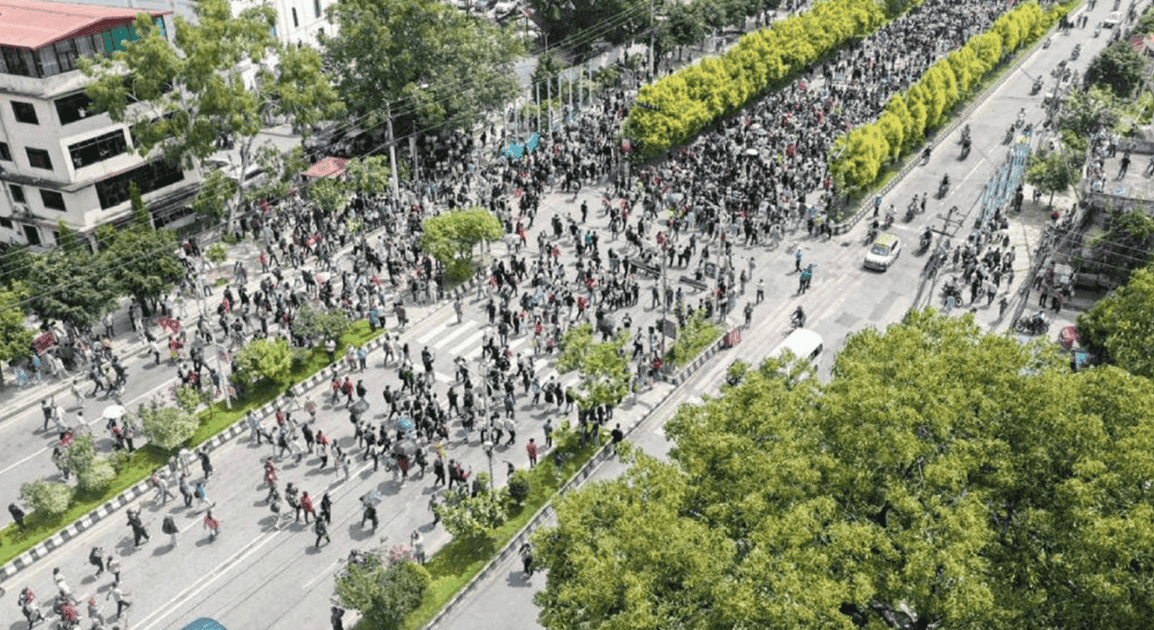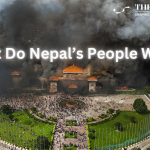The new wave of youth-led protests that has unfolded in Nepal, referred to frequently as the “Gen Z movement,” has garnered an international attention. The protests were ignited by the government’s ban on several social networks, and quickly transformed into a larger movement against corruption, nepotism, and a lack of accountability from the political ruling class. This mix of grievances consequently begs the question: are these protests a signal of the unraveling of Nepal’s hard-fought democratic project, or are they a vigorous sign of its renewal?
The government, with its disproportionate actions against the protests, and the entrenched problems which underpin this discontent, may signal a democracy that is at risk. Other looks at this protest movement may suggest that it is fundamentally a necessary part of participatory democracy in Nepal with young people forcefully demanding the promises of democracy are met – not an indication of decay of the system but a powerful call for its reinvigoration.
Yawing Inequality
To understand the core of these protests, one must look beyond the immediate catalyst of the social media ban. The ban, introduced towards the end of 2025 under the ruse of fighting online crime and requiring foreign firms to register locally, was largely seen as an act of censorship intended to silence dissent. Nepal’s digitally native youth, for whom platforms like Facebook, X, and YouTube are integral spaces for communication, commerce, and political organizing; therefore, they were not bothered about reporting online crime.
But these protests were not only about the ban, but they were also about much longer running grievances. A nascent “Nepo Kid” campaign had already gained traction online, with viral content on TikTok and others contrasting the extravagant lifestyles of politicians’ children with the daily struggles of ordinary citizens. It showed the yawning inequality chasm, and the common belief in the corruption and unaccountability of an elite that had grabbed the state for personal gain. The social media ban, therefore, was not the cause, but the last straw— the spark that ignited the tinder bottle of generational grievances.
Legitimacy is the Elixir of Political Power
The assertion that these protests indicate democratic decay is not without foundation. Since the abolition of the monarchy in 2008, Nepal’s political history has been fraught with instability. Governments seem to come and go at an alarming rate and the political feuding appears never-ending. The country has had thirteen governments in the last sixteen years, reflecting a political culture more focused on power-sharing and self-interest than on national progress. In fact, corruption permeates all levels of society – referring to the major political scandals involving known politicians down to bribery. All of this adds up to a significant lack of faith – the same becomes true for references to human rights and reports that consistently reveal a culture of impunity in society in which abuses by security services, and even an ability to “dismiss” abuses, are glossed over.
Critics of the government can encounter swift attempts to suppress. It is significant to note when a government employing violence against nonviolent protest in a democratic society. If true civil servants who really “care” for their nation and citizens are not responsible for people’s ability to gather and express their points of view, this would suggest they do not look kindly on civil rights like freedom of expression, freedom of assembly, or perhaps more poignantly, their limitations to promote violence as a civil servant. Thus, the Gen Z protests can be seen as a predictable consequence of a system failing to provide them a healthy future – their last gasp after running out of faith in a broken system that has refused to listen to them.
How Nepal is a maturing as a participatory democracy?
Nevertheless, this outlook fails to appreciate the restorative and dynamic anatomy of a functioning democracy. However, their discontent has birthed protests, protests are still a democratic act. Mass protests are a collective popular challenge to an existing paradigm; they are a direct exercise of the people’s power to make their leaders accountable to them. Unlike earlier protests or environmental movements which were either coopted or led overtly by political parties, the Gen Z protests were leaderless and “spontaneous” and I use this word cautiously, organized in a decentralized digital way.
Let me say that being leaderless is a testament to the growing maturity of Nepal’s civic society; it demonstrates that citizens no longer need a “leader” — (i.e., a charismatic individual) or a political party to organize around. They can now mount a collective protest to demand accountability. This is what a robust democracy is looking for – for the citizen to engage their democracy; in other words, as a civilization we can no longer passively accept the wrongdoings of the officials we elect. Hence, the protesters weren’t calling for anarchy, but rather they were calling for a specific political request to reset the system when they insisted on the mass resignation of parliamentarians and new elections.
Democracy is Trans generational
Moreover, the protests are bringing attention to the culture of impunity that has developed in Nepal. By showing the lifestyles of the “Nepo Kids” and making public instances of corruption, Gen Z is reshaping the idea of political engagement. By reflecting back on the ruling class at the same time as they reflect back on their community, they are forcing a conversation about inequality, justice, and a moral contract to the state and their fellow citizens. This marks a key political moment of collective democratic renewal.
A democracy cannot exist when people become disillusioned and disengaged. The fact that a generation, which may not have direct memories of the struggle for democracy in the 2006 movement, is purposely, passionately, and creatively occupying the streets means the democratic ideal is not dead. It means it is alive and has been taken over by another generation – one that has developed different tools and conceptions of justice and accountability.
While the violence and state crackdown involved in the most recent protests in Nepal is troubling and reflective of a democratic system under serious tension, the protests themselves are not a disintegration, but rather a significant and powerful renewal process. The protests tell us that the youth of Nepal are not prepared to simply inherit a broken political system. They are acting on their democratic rights, constructing new and modern avenues to organize and voice their frustration. Their actions are reflecting on the ruling class, forcing a confrontation with the systemic corruption and nepotism that undermined the collective trusts of the public. We are unsure of where it is all leading, but it is certainly evident that this generation’s engagement is vital dis-consensus to a decidedly complacent system.





